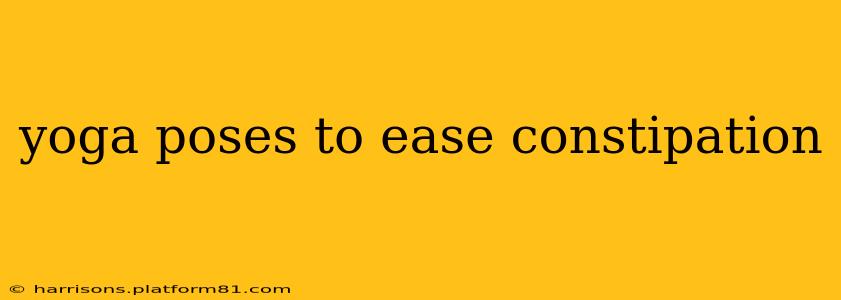Constipation, that frustratingly common digestive issue, affects millions. While medication can sometimes be necessary, many find relief through lifestyle changes, including incorporating yoga into their routine. Certain yoga poses can gently stimulate the digestive system, promoting regular bowel movements and easing discomfort. This comprehensive guide explores effective yoga poses and provides valuable insights into improving your digestive health.
Understanding the Gut-Brain Connection:
Before diving into specific poses, it's crucial to understand the connection between your gut and your nervous system. Stress and anxiety can significantly impact digestion, leading to constipation. Yoga, with its emphasis on mindful movement and breathwork, can help calm the nervous system, indirectly promoting better bowel function. This holistic approach is key to long-term relief.
Yoga Poses for Constipation Relief
Here are some effective yoga poses that can help alleviate constipation:
1. Bālāsana (Child's Pose):
This restorative pose gently massages the abdominal organs, promoting blood flow and easing tension in the belly. Hold for 1-3 minutes, breathing deeply.
2. Uttānāsana (Standing Forward Bend):
This pose gently inverts the body, stimulating blood flow to the abdominal area and potentially aiding in bowel movement. Hold for 30 seconds to 1 minute, relaxing into the stretch.
3. Pāścimottānāsana (Seated Forward Bend):
Similar to Uttānāsana, this seated variation also gently compresses the abdomen, stimulating the digestive organs. Hold for 30 seconds to 1 minute, focusing on your breath.
4. Viparita Karani (Legs-Up-the-Wall Pose):
This restorative inversion helps to improve circulation, relieve stress, and calm the nervous system – all factors that can contribute to constipation relief. Lie on your back with your hips close to a wall and your legs resting against it. Stay for 5-10 minutes.
5. Matsyasana (Fish Pose):
This gentle backbend stretches the abdomen and chest, aiding in digestion. Hold for 30 seconds to 1 minute. Be mindful of your back and avoid overstretching.
6. Apanāsana (Knee-to-Chest Pose):
This pose gently massages the abdominal organs and relieves tension in the lower back, potentially easing constipation. Hold for 1-3 minutes per side.
7. Supta Matsyendrasana (Reclined Spinal Twist):
This twist gently massages the abdominal organs and stimulates the digestive system. Hold for 1-3 minutes per side.
8. Jathara Parivartanasana (Revolved Abdomen Pose):
Similar to the reclined spinal twist, this pose massages the abdominal organs and promotes better digestion. Hold for 1-3 minutes per side.
Twists and Inversions: The Power of Gentle Stimulation
Many of the poses listed above incorporate twists and inversions. These movements are particularly beneficial for stimulating the digestive system. Twists gently massage the internal organs, helping to move things along, while inversions can improve blood flow to the abdominal region, further enhancing digestive function.
Breathing Techniques (Pranayama) for Digestive Health:
Incorporating breathing exercises like Dirga Pranayama (three-part breath) or Ujjayi Pranayama (ocean breath) can further enhance the benefits of yoga for constipation. Deep, conscious breathing helps to calm the nervous system and promote relaxation, which is crucial for healthy digestion.
How Often Should I Practice?
Consistency is key. Aim for at least 20-30 minutes of yoga practice most days of the week. Listen to your body, and don't push yourself too hard, especially when starting.
Beyond Yoga: Holistic Approaches to Constipation Relief
While yoga can be incredibly helpful, it’s important to remember it's part of a broader approach. Maintaining a balanced diet rich in fiber, staying hydrated, and managing stress are all crucial for preventing and relieving constipation. If your constipation persists or worsens, consult a healthcare professional.
Disclaimer: This information is for educational purposes only and is not intended as medical advice. Always consult with a healthcare professional before starting any new exercise program, especially if you have any underlying health conditions.
